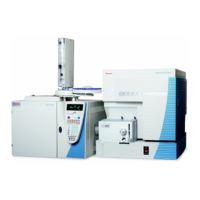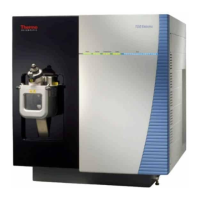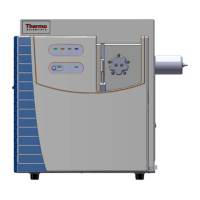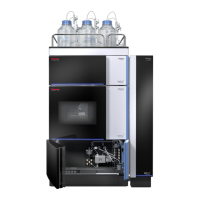2
Functional Description
Mass Spectrometer
36 TSQ Series Hardware Manual Thermo Scientific
accelerated farther into the cathode, drawn by the increasingly positive potential gradient.
The funnel shape of the cathode causes the ejected electrons not to travel far before they again
strike the inner surface of the cathode, which causes the emission of more electrons. A cascade
of electrons is then created that finally results in a measurable current at the end of the
cathode where the anode collects the electrons. The current collected by the anode is
proportional to the number of secondary particles striking the cathode.
Figure 29. Ion detection system, showing the electron multiplier (top) and conversion dynode
(bottom)
Typically, the electron multiplier is set to a gain of about 3 × 10
5
(that is, for each ion or
electron that enters, 3 × 10
5
electrons exit) in MS mode and 2 × 10
6
in MS/MS mode. The
electrometer circuit converts the current that leaves the electron multiplier via the anode to a
voltage and the data system records the voltage.
The ion detection system of the TSQ mass spectrometer increases signal and decreases noise.
The high voltage applied to the conversion dynode results in a high conversion efficiency and
increased signal. That is, for each ion striking the conversion dynode, many secondary
particles are produced. The increase in conversion efficiency is more pronounced for more
massive ions than it is for less massive ions.
Because of the off-axis orientation of the ion detection system relative to the mass analyzer,
neutral molecules from the mass analyzer tend not to strike the conversion dynode or electron
multiplier. As a result, noise from neutral molecules is reduced.

